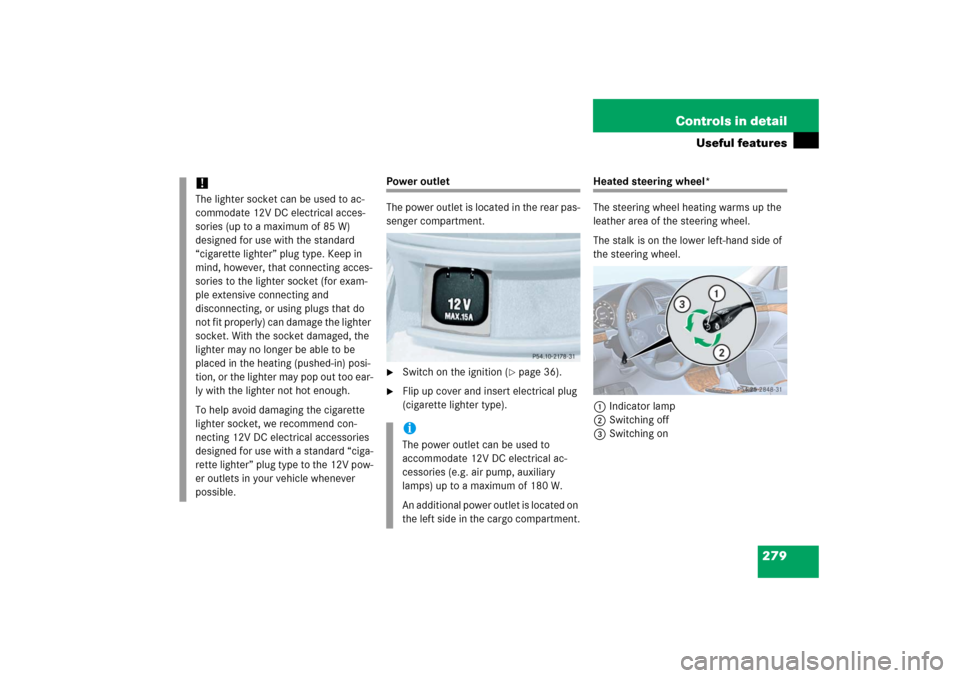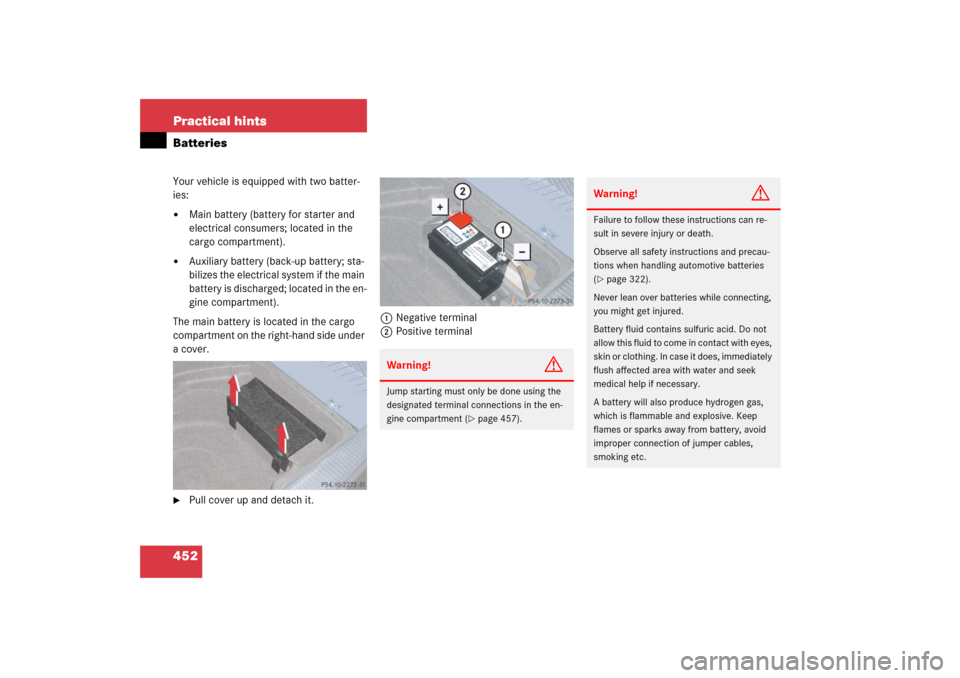Page 280 of 521

279 Controls in detail
Useful features
Power outlet
The power outlet is located in the rear pas-
senger compartment.�
Switch on the ignition (
�page 36).
�
Flip up cover and insert electrical plug
(cigarette lighter type).
Heated steering wheel*
The steering wheel heating warms up the
leather area of the steering wheel.
The stalk is on the lower left-hand side of
the steering wheel.
1Indicator lamp
2Switching off
3Switching on
!The lighter socket can be used to ac-
commodate 12V DC electrical acces-
sories (up to a maximum of 85 W)
designed for use with the standard
“cigarette lighter” plug type. Keep in
mind, however, that connecting acces-
sories to the lighter socket (for exam-
ple extensive connecting and
disconnecting, or using plugs that do
not fit properly) can damage the lighter
socket. With the socket damaged, the
lighter may no longer be able to be
placed in the heating (pushed-in) posi-
tion, or the lighter may pop out too ear-
ly with the lighter not hot enough.
To help avoid damaging the cigarette
lighter socket, we recommend con-
necting 12V DC electrical accessories
designed for use with a standard “ciga-
rette lighter” plug type to the 12V pow-
er outlets in your vehicle whenever
possible.
iThe power outlet can be used to
accommodate 12V DC electrical ac-
cessories (e.g. air pump, auxiliary
lamps) up to a maximum of 180 W.
An additional power outlet is located on
the left side in the cargo compartment.
Page 309 of 521

308 OperationDriving instructionsRoad salts and chemicals can adversely af-
fect braking efficiency. Increased pedal
force may become necessary to produce
the normal braking effect.
Depressing the brake pedal periodically
when traveling at length on salt-strewn
roads can bring road-salt-impaired braking
efficiency back to normal.
If the vehicle is parked after being driven
on salt-treated roads, the braking efficien-
cy should be tested as soon as possible af-
ter driving is resumed.
For more information, see “Winter driving”
(
�page 355).
Standing water
Warning!
G
Make sure not to endanger any other road
users when carrying out these braking ma-
neuvers.
Warning!
G
If the vehicle becomes stuck in snow, make
sure that snow is kept clear of the exhaust
pipe and from around the vehicle with the
engine running. Otherwise, deadly carbon
monoxide (CO) gases may enter vehicle in-
terior resulting in unconsciousness and
death.
To assure sufficient fresh air ventilation,
open a window slightly on the side of the ve-
hicle not facing the wind.Warning!
G
The outside temperature indicator is not de-
signed to serve as an ice-warning device and
is therefore unsuitable for that purpose. In-
dicated temperatures just above the freez-
ing point do not guarantee that the road
surface is free of ice.
!Do not drive through flooded areas or
water of unknown depth. Before driving
through water, determine its depth.
Never accelerate before driving into
water. The bow wave could force water
into the engine and auxiliary equip-
ment, thus damaging them.
If you must drive through standing wa-
ter, drive slowly to prevent water from
entering the passenger compartment
or the engine compartment. Water in
these areas could cause damage to
electrical components or wiring of the
engine or transmission, or could result
in water being ingested by the engine
through the air intake causing severe
internal engine damage. Any such dam-
age is not covered by the
Mercedes-Benz Limited Warranty.
Page 323 of 521

322 OperationEngine compartmentBatteries
Your vehicle is equipped with two
batteries:�
Main battery (located in the cargo
compartment).
�
Auxiliary battery (located in the engine
compartment).
These batteries should always be suffi-
ciently charged in order to achieve their
rated service life. Refer to Maintenance
Booklet for battery maintenance intervals.
If you use your vehicle mostly for short-dis-
tance trips, you will need to have the bat-
tery charge checked more frequently.When replacing batteries, always use bat-
teries approved by Mercedes-Benz.
If you do not intend to operate your vehicle
for an extended period of time, consult an
authorized Mercedes-Benz Center about
steps you need to observe.
Batteries contain materials that can harm
the environment if disposed of improperly.
Recycling of batteries is the preferred
method of disposal. Many states require
sellers of batteries to accept old batteries
for recycling.
G
Observe all safety instructions
and precautions when handling
automotive batteries.
A
Risk of explosion
D
Keep flames or sparks away
from battery. Do not smoke.
B
Battery acid is caustic. Do not
allow it to come into contact
with skin, eyes or clothing.
In case it does, immediately
flush affected area with clean
water and seek medical help if
necessary.
E
Wear eye protection.
C
Keep children away.
F
Follow the instructions in this
Operator’s Manual.
Page 453 of 521

452 Practical hintsBatteriesYour vehicle is equipped with two batter-
ies:�
Main battery (battery for starter and
electrical consumers; located in the
cargo compartment).
�
Auxiliary battery (back-up battery; sta-
bilizes the electrical system if the main
battery is discharged; located in the en-
gine compartment).
The main battery is located in the cargo
compartment on the right-hand side under
a cover.
�
Pull cover up and detach it.1Negative terminal
2Positive terminal
Warning!
G
Jump starting must only be done using the
designated terminal connections in the en-
gine compartment (
�page 457).
Warning!
G
Failure to follow these instructions can re-
sult in severe injury or death.
Observe all safety instructions and precau-
tions when handling automotive batteries
(�page 322).
Never lean over batteries while connecting,
you might get injured.
Battery fluid contains sulfuric acid. Do not
allow this fluid to come in contact with eyes,
skin or clothing. In case it does, immediately
flush affected area with water and seek
medical help if necessary.
A battery will also produce hydrogen gas,
which is flammable and explosive. Keep
flames or sparks away from battery, avoid
improper connection of jumper cables,
smoking etc.
Page 480 of 521
479 Technical data
Electrical system
�Electrical system
Model
E 350, E 350 4MATIC
E 500, E 500 4MATIC
E55AMG
Generator (alternator)
14 V/150 A
14 V/150 A
14 V/180 A
Starter motor
14 V/1.7 kW
14 V/1.7 kW
14 V/1.7 kW
Battery (auxiliary)
12 V/12 Ah
12 V/12 Ah
12 V/12 Ah
Battery (main)
12 V/95 Ah
12 V/95 Ah
12 V/95 Ah
Spark plugs
Bosch Platin Y 7 MPP33
NGK PLKR 6A
Bosch F8 DPP 332U
NGK PFR 5R-11
NGK IL FR 6 A
Electrode gap
0.031 in (0.8 mm)
0.039 in (1.00 mm)
0.031 in (0.8 mm)
Tightening torque
15 - 22 lb-ft (20 - 30 Nm)
18.5 - 22 lb-ft (25 - 30 Nm)
18.5 - 22 lb-ft (25 - 30 Nm)